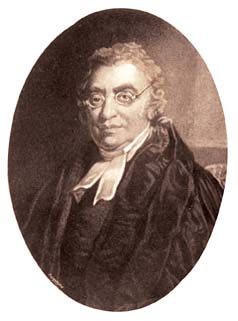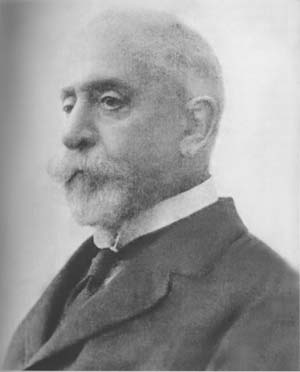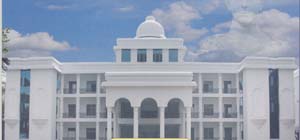| (ARCHIVE) Vol. XX No. 8, august 1-15, 2010 |
|
Quick Links
Andrew Bell and the Madras System
A tug that remembered a harbour builder
Nostalgia: A slice of Lloyd’s Road
From Capper House to Kalaignar Maaligai
Parvathamalai of the siddha-s
|
|
Andrew Bell (b. 1753, St. Andrew’s, Scotland) graduated in Mathematics in Scotland. After a seven-year stint as a tutor in Virginia, America, he returned to Scotland and was ordained as a deacon. He then came to India. He arrived in Madras to take charge as the Minister of St. Mary’s Church in the Fort and as Chaplain of Fort St George. The East India Company directed that a seminary be established in Madras for the education and maintenance of orphans of European military personnel. That this ‘seminary’ evolved into the Male Military Asylum in Madras is well known. Bell, who was appointed as the Superintendent of the Asylum in 1789, declined the offered salary of 1200 pagodas (£ 480).
|

Andrew Bell
|
Because he was unsuccessful in retaining qualified teachers, he tested out the practice of using senior learners ‘to teach’ juniors. He developed ‘mutual instruction’ as a method to impart education. The first practice he introduced was teaching the letters of alphabet by making the learners write them on sand.
He had observed the practice of writing on sand and using seniors to mentor juniors in a native school in Calicut. The next practice he tested was learning to read by the syllables: the learner would proceed to pronounce two-syllable words only after learning to read and spell one-syllable words. Right from the beginning, he made learners do everything by, and for, themselves. Every learner maintained a register of the quantum of work he performed, so that the learner’s care in performances and progress towards it could be compared. A black book was also maintained in which all school offences were recorded and this book was examined weekly. In almost every instance of wrong behaviour, Bell would make other boys judge the offender. Bell was convinced that their decisions were impartial. But he urged the teachers to minimise offences.
Bell’s singular aim was to redeem the children from the stigma they suffered and to make them men of high character and good Christians. After supervising the school for seven years, he decided, for health reasons, to return to England. He said at the time of his departure:
“This numerous family I have long regarded as my own. These children are, indeed, mine by a thousand ties! I have for them a parental affection, which has grown upon me every year. For them I have made such sacrifices as parents have not always occasion to make for their children; and the nearer the period approaches when I must separate myself from them, the more I feel the pang. I shall suffer in tearing myself from this charge, and the anxious thoughts I shall throw back upon these children, when I shall cease to be their protector, their guide, and their instructor.”
Eleven years after he had left India, Bell received a letter, signed by 42 of his pupils, expressing in the strongest terms their gratitude for the instruction and care which he had bestowed upon them in their childhood.
On return to England, Bell in 1797 published an article entitled ‘An experiment in education, made at the male asylum of Madras; suggesting a system by which a school or family may teach itself, under the superintendence of the master or parent.’ The theme of this article enunciated Bell’s concept of the Madras Monitorial System of Education (or, simply, the Madras Education System), which was adopted in nearly 10,000 schools in the UK and many schools in the recently independent America. Jana Tschurenev, in a paper published in Paedagogica Historica (vol. 44) in June 2008, refers to the origins of the monitorial system in the Male Military Asylum in Madras, its export to London, where it was developed into a standardised model, and its subsequent ‘import’ into India.
Bell died on January 27, 1832 and was buried in Westminster Abbey, Archbishop of Canterbury and the Bishop of London conducting the service. The Madras College, a comprehensive secondary school, founded a year after his death in St. Andrews in Scotland, commemorates his name today.
Back to top
|
|
|
|
|
Sir Francis Spring was one of the best known civil engineers in India in the late 19th-early 20th Centuries. He was the Chairman of the Madras Port from 1904 and is considered the real father of this harbour. He was also responsible for helping the great mathematician Ramanujan, who was then a tally clerk in Madras Port. He is remembered by a road named after him in the Port area and also a wet basin. But what really lived upto its name was the steam tug Sir Francis Spring!
|

Sir Francis Spring
|
A steam Kort nozzle tug was built for Madras harbour in the Hooghly dock of Calcutta in 1939 and was named Sir Francis Spring in this great engineer’s memory. This was the first tug to be built with a Kort nozzle which was imported from the UK. A Kort nozzle is a shroud around the propeller of a floating craft which, as proved by Dr. Kort of Germany, gave the tug an extra thrust for the same horsepower developed by the propelling engines. This was proved by a man who was neither a naval architect nor a marine engineer, but an aerodynamics specialist. He proved that the same principles of current movements in the air hold good in water too and invented this shroud – not by design but by accident!
The banks of the river Rhine were getting eroded by the wake of propeller wash, and the civil administration wanted the boat owners to do something about it. Dr. Kort was consulted about having the wash diverted and he suggested two half- shrouds on either side of the propeller. It did the work and the propeller wash was taken aft in a straight line. In the bargain, boat owners found that they could add another barge, as the pull had increased due to the straight diversion of the stream!
When informed of this, Dr. Kort designed the modern Kort Nozzle, and tugs the world over started using this equipment.
In India, Sir Francis Spring was the first tug to have this facility.
This tug had steam reciprocating engines and Scotch boilers. It served the port well for over three decades when it was decided to decommission her. The old work-horse was put to rest and an advertisement issued for her sale.
The vessel would have gone to the butchers, as the ship breakers were then known, but Visakhapatnam Port was in urgent need of a tug and, after negotiations, it purchased the tug from the then Madras Port Trust for a throwaway price.
This tug was not seaworthy and, as it could not sail on its own, had to be towed to Visakhapatnam. When G. Viswanath, the then Dy. Chief Mech. Engineer of Vizag Port, came to secure passage clearance from the Mercantile Marine Department in Madras, he was heckled by the principal officer, who thought that it was madness to venture out in such a vessel. Undaunted, Viswanath set about making the required safety precautions and, with remarkable perseverance, got the clearance to tow the tug to Vizag.
That the tug worked for further two years after reaching Visakhapatnam was proof enough to show that, like the man it was named after, the tug too was a staunch believer in hard work!
Back to top
|
|
|
|
|
Who was Lloyd that he should lend his name to a road? I lived
on Lloyd’s Road as a child in the late 1930s and now the name of the road is going to be changed.
I had long planned to go down Lloyd’s Road to literally “go down memory lane” and re-live a bit of my childhood. The road was sliced into two by the Royapettah High Road (as it is today) with the tram lines going on to Royapettah, Mount Road and Parry’s Corner. We stayed in the eastern half that leads to the Marina.
It was a good and quiet neighbourhood to live in. At the end of one side of the road, abutting the Royapettah High Road, was a stately house called Haridwar with a huge garden.
It belonged to a prosperous advocate Rajah Iyer. Navarathri was celebrated in his house on a grand scale with electric gadgets which made toy trains run and dolls dance. He had built twin houses, Chandra Villa and Surya Villa, for his two daughters. We stayed in one of them.
Opposite our house was another stately house which was the only one that had a radio (that was in 1936), so everyone called it the ‘Radio House’. The radio used to be played loud and clear all the time and we listened to news bulletins that began with “This is All India Radio giving you the News.” Ours was the second house to have a radio, which my father bought for the princely sum of Rs. 450 which he could ill-afford. The radio, called ‘Golden Voice’, had seven valves (whatever that meant). He bought it to celebrate the results of his children. My brother passed the European High School examination and I the Middle School examination, both of us with First Classes.
On one sided of our house there was a bit of vacant land and beyond that there was a house with such a large garden that it stretched all the way upto Royapettah High Road. A little girl of my age lived there. She was very frail and not allowed to play with anyone. We never met her mother, but she would send baskets of mangoes, sapota and other fruits from her garden. On the other side of the twin houses lived the Coelhos. Mr. Coelho was an advocate with six children, two of them daughters with whom I used to play in the large garden that surrounded their house. Opposite this house, a young couple, Mr. and Mrs. Rao, lived in a house that was too large for them and their newborn baby.
Almost opposite our house there was vacant land with a very small house at the end of the garden with a tank right in front called ‘Thagara Kollam’ – a tank cordoned off by iron railings. Lotuses used to bloom in this tank – unbelievable to think that such a place ever existed! Tailoring and embroidery classes were run there.
In all, that slice of Lloyd’s Road contained no more than ten houses, all with gardens full of neem, mango, guava and banana trees that attracted birds such as parakeet, drongo, koel and kingfisher.
I walked down Lloyd’s Road recently and got the shock of my life. All that I had known and remembered had been completely wiped out. There was not one single house or bit of vacant land on the road as I knew. Ugly buildings lined either side of the road which was full of traffic. Rajah Iyer’s house has been turned into a hideous mall. The quiet road where I once started to learn cycling no longer existed except in my memory and my memories were crushed cruelly as I looked at the monstrosities that had come up
I welcome the move to rename the road.
It can never be the Lloyd’s Road that I knew…
I wish I had never taken that walk.
Back to top
|
|
|
|
|
Queen Mary’s College has got what it feels is a suitable replacement for its first home, Capper House, in Kalaignar Maaligai which at least in its portico reflects Capper House, a design which could have been easily replicated on the ground floor corridor. When a portion of Capper House (left) collapsed some years ago, the rest of it was considered safe and restorable by the heritage experts, but the authorities pulled it down with nary a word from anyone connected with the College. Protests began much later – when a move from this campus was envisaged, the only heritage building the campus had long on. Now, in its place has come Kalaignar Maaligai, and everyone is happy. We wish them well in a building that necessarily must have a dome to keep in line with the latest PWD architectural perks.
|

|
For the record, QMC had its genesis as The Madras College for Women in 1914. In 1918, the name of the college was changed to Queen Mary’s College. The founder Principal of the College was Miss Dorothy De La Hey, who was to play a significant role in the empowerment of Indian women. The College was affiliated to the University of Madras in 1916. Autonomy was granted in 1987.
The study of Geography and Home Science encouraged by Principal Dr. Iravathy moved the College to the forefront. She is considered the architect of Geographical Studies in the College, the University and the State.
Back to top
|
|
|
|
|
Parvathamalai is a part of the Javadhu hills of the Eastern Ghats, about 25 km from Polur in Tiruvannamalai District. The height of the hill is about 3500 feet. There is a temple for Lord Siva at the top. He goes by the name Mallikarjunaswamy here: The hill is considered very auspicious. People refer to Parvathamalai as Southern Kailasam.
Many siddhar-s once lived and practised their mystical powers on this hill, which is covered with medicinal plants. The scented herbal breeze on this hill is believed to cure even incurable diseases.
There are several other temples on the hill, including the Goddess Pachaiamman temple, the Lord Veerabhadra temple with its herbal park, and the Renugambal temple in front of the herbal pond known as ‘Agaya Gangai’. It is believed that if a person bathes in the water of this pond, he will be cured of all body pain and fatigue. The Vana Durga temple is on the way to the main hill temple, the siddhar’s temple is also on the way, and the Kadaparai Siva temple is the last temple on the way to the hilltop temple. Those who cannot climb the hill perform their pooja here and return back.
It is believed that there is an underground whirlpool which heals all diseases.
The Parvathamalai Forest is an undisturbed portion of the Eastern Ghats, all of which was once densely forested. The entire Parvathamalai is protected as a reserve forest. There are about 152 plant species recorded on this hill. Very rare herbal plants found include: peyviratti (Anisomeles malabarica), karunthulasi (Ocimum sanctum), karunochi (Justicia gendarussa/Gendarussa vulgaris), karu umathai (Datura fastuosa), karunelli (Phyllanthus reticulatus), civanar vembu (Indigofera aspalathoides), mahavilvam (Limonia acidissima), vellerukku (Calotropis procera), and orithazh thaamarai (Lonidium suffruticosum).
These plant species are characteristic of this area alone. As far as fauna are concerned, there are about 128 species of animals, of which there are 17 species of mammals, 22 species of reptiles and 89 species of birds. Some of the animal species are IUCN-categorised animals, including the Star tortoise, the Orange-breasted green pigeon and the Slender loris, that belong to the rare animal species and the Barheaded goose, Blackbuck and Civet cat that belong to the threatened and endangered category.
A variety of factors threaten the sacred mountain environment. The forest stretches
leading to the temples are degraded due to the disposal of polythene materials (bags, cups, etc.) by devotees and due to the clearing of vegetation by the pilgrims to keep away poisonous snakes from the path. (Courtesy: Eco News, the journal of CPREEC)
Back to top
|
|
|
|
|